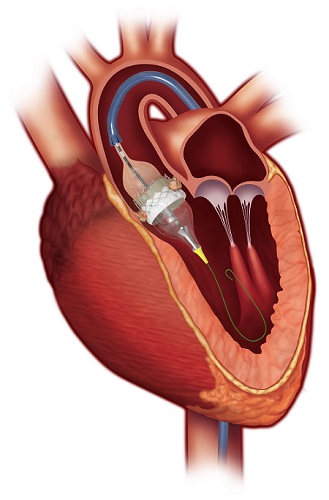TAVR Procedure
 Transcatheter aortic valve replacement (TAVR) is a minimally invasive procedure
to replace a damaged heart valve while leaving the old valve in place.
Heart valves are tissue paper-thin membranes attached to the heart wall
that constantly open and close to regulate blood flow causing the sound
of a heartbeat. A normal, healthy heart valve minimizes any obstruction
and allows blood to flow smoothly and freely in one direction. When there
is a narrowing of the heart's aortic valve opening, it’s called
aortic stenosis. calcium build-up, a birth defect, rheumatic fever, and
radiation therapy can all cause obstruction and need for a new valve.
This exciting new technology has been utilized in Europe since 2002 and
available in the United States since 2011.
Transcatheter aortic valve replacement (TAVR) is a minimally invasive procedure
to replace a damaged heart valve while leaving the old valve in place.
Heart valves are tissue paper-thin membranes attached to the heart wall
that constantly open and close to regulate blood flow causing the sound
of a heartbeat. A normal, healthy heart valve minimizes any obstruction
and allows blood to flow smoothly and freely in one direction. When there
is a narrowing of the heart's aortic valve opening, it’s called
aortic stenosis. calcium build-up, a birth defect, rheumatic fever, and
radiation therapy can all cause obstruction and need for a new valve.
This exciting new technology has been utilized in Europe since 2002 and
available in the United States since 2011.
Do I Qualify?
TAVR is for patients who have been diagnosed with severe aortic stenosis and is an alternative to open heart surgery for many patients. A cardiologist will do a series of tests such as a chest X-ray, echo, angiogram, and others to determine the severity of the stenosis and if surgery or TAVR is the right treatment. As much as possible, we schedule tests at the Methodist facility closest to you.
How Does TAVR Work?
During the procedure, an interventional cardiologist, cardiothoracic surgeon, and TAVR team work together in the operating room to thread the catheter up the femoral artery in the groin to the heart. Doctors can also make an incision in the lower left side of a patient’s chest under the rib cage, or in the upper chest to access the heart. The new valve is crimped down to the approximate diameter of a pencil and placed on a catheter. Once in the heart chamber, the new valve is positioned directly inside the aging aortic valve where the catheter balloon is inflated to secure it in place. The valve will then begin to work immediately and will function like a normal, healthy valve.
Patients usually stay in the hospital for a few days to make sure the new valve is working properly, but recovery is generally pretty easy and outcomes are very good.
After The Procedure
Patients may be taken to the ICU or directly to a hospital room. Doctors and the care team will give patients specific instructions to help with recovery, which may include a special diet, exercise, and medicine. Regular check-ups with are very important. Call or see your doctor whenever you have questions or concerns about your health, especially if you experience any unusual problems such as bleeding, pain, other discomfort, or changes in your overall health.
TAVR is performed at Methodist Dallas Medical Center and Methodist Richardson Medical Center.
To find a doctor or request an appointment,
call
(214) 947-0000 or
click to schedule.

